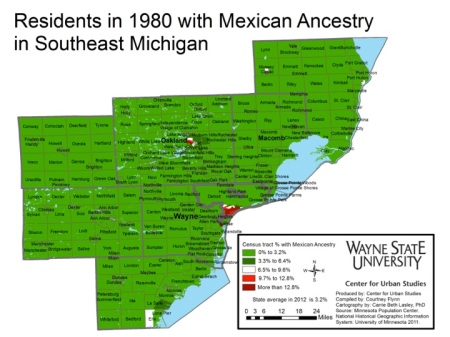The first residents of Michigan with Mexican ancestry arrived in the early 20th Century as recruited farm labor in the state’s beet fields, or came to Detroit to work in assembly lines (Herrada, 2007). Beets crashed in the early 1920s leading to a farm-to-factory migration of Mexican-Americans from rural Michigan to Detroit, nearly quadrupling the urban population to 15,000 before the Great Depression (Herrada, 2007). Due to the high rates of unemployment during the Great Depression, the City of Detroit, federal government and Mexican government adopted a policy that stated unemployed workers would have to move back to Mexico to live in newly formed agricultural colonies, on marginal land. The urban population dropped to about 1,200. (Herrada, 2007). These residents remained clustered in Southwest Detroit near Holy Trinity Catholic Church. In the 1940s though, a federal effort was made to bring in labor from Mexico to work on Detroit wartime industries (Alvarado & Alvarado, 2003).
As in many part of the United States, the number of Mexican immigrants grew in the post-War years. A number of service, political, cultural and religious organizations focused on Latino – and predominantly Mexican American — causes and interests began to flourish in Southwest Detroit and Pontiac in the 1960s and 1970s. Beginning in 1970s, Mexican American communities formed in into other neighborhoods in Detroit, including the area around Greenfield and Grand River as well as the North End area, west of Woodward . The population also grew in Redford and Plymouth (Wayne County),Monroe Monroe County, Ypsilanti (Washtenaw County), Capac (St. Clair County); and Hartland (Livingston County) (Alvarado & Alvarado, 2003).
Many of those clusters were still present in 1980. The 1980 Census reported more than 130,000 residents in Southeast Michigan claiming Mexican ancestry. More than 72,000 were in Wayne County, followed by Oakland County with 27,000 residents claiming Mexican ancestry. A look at where residents with Mexican ancestry were located in the 1980s shows clusters that had already formed in Southwest Detroit and near Pontiac with smaller clusters in Erie Township in Monroe County and Capac in St. Clair County.
The following chart shows the growth in residents with Mexican ancestry in the region using Census data and the American Community Survey’s 2012 5-year estimates. It shows consistent growth across counties and over time:
Flashing forward to 2012, the Mexican-American population in the region has nearly tripled since 1980. The Interstate corridors in Livingston and Washtenaw are seeing an influx of residents with Mexican ancestry. Enclaves near Monroe city and Capac have expanded too. In Capac’s case, neighboring Mussey and Berlin townships now exceed the state average. The corridor between Howell and Brighton in Livingston is now 11.6% residents with Mexican ancestry. The outskirts of Ann Arbor have also seen an increase in the proportion of residents with Mexican ancestry.
The enclave that began in Pontiac in Oakland County has expanded outward to adjacent areas, such as Auburn Hills and Waterford. There are now 13 Census tracts with more than 10 percent of the population claiming Mexican ancestry. Areas along the Interstate 75 corridor in Macomb are also seeing a growth in their population with Mexican ancestry, especially in multi-ethnic Sterling Heights and northward.
The number of residents claiming Mexican ancestry in the Downriver area of Wayne County has grown proportionally as well. Areas such as Melvindale, Lincoln Pak and Allen Park have Mexican-American populations that exceed 10 percent.
Southwest Detroit, often referred to as “Mexicantown” expanded and became more densely Mexican by 2012. Most of the area is comprised of Census blocks with more than 30 percent of the population identifying as having Mexican ancestry. One tract even contains 50.2 percent of residents reporting .
Works Cited
Alvarado, R., & Alvarado, S. (2003). Discovering the Peoples of Michigan: Mexicans and Mexican Americans in Michigan. East Lansing, MI: Michigan State University Press.
Herrada, E. (2007). History of Latinos in Michigan and Detroit. Detroit, MI.http://www.umich.edu/~ac213/student_projects07/repatriados/index.html





